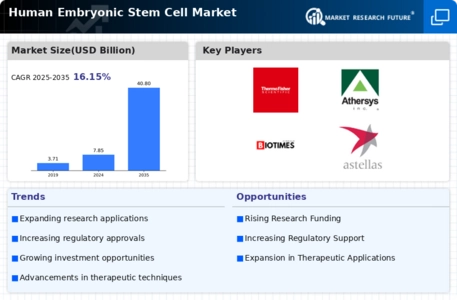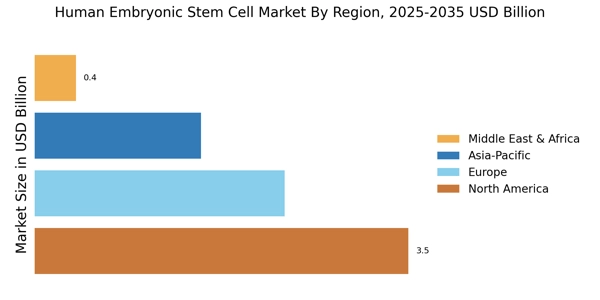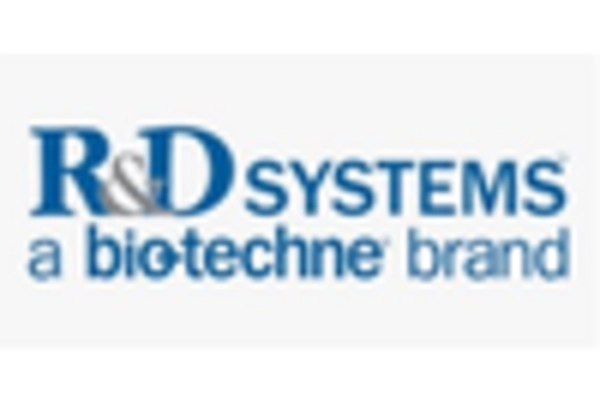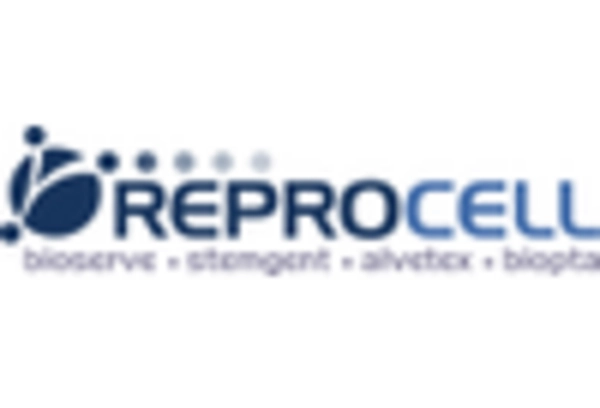Advancements in Regenerative Medicine
The Human Embryonic Stem Cell Market is experiencing a surge in interest due to advancements in regenerative medicine. These stem cells possess the unique ability to differentiate into various cell types, making them invaluable for treating degenerative diseases. Research indicates that the market for regenerative medicine is projected to reach approximately 50 billion dollars by 2026, driven by the increasing prevalence of chronic diseases. As researchers continue to explore the therapeutic potential of human embryonic stem cells, the industry is likely to witness a significant uptick in funding and innovation. This momentum suggests that the Human Embryonic Stem Cell Market will play a pivotal role in shaping future medical treatments, potentially leading to breakthroughs in areas such as organ transplantation and tissue engineering.
Growing Demand for Personalized Medicine
The Human Embryonic Stem Cell Market is poised for growth as the demand for personalized medicine escalates. Personalized medicine aims to tailor treatments based on individual genetic profiles, and human embryonic stem cells offer a promising avenue for developing such therapies. The market for personalized medicine is expected to exceed 2 trillion dollars by 2030, reflecting a shift towards more individualized healthcare solutions. This trend indicates that the Human Embryonic Stem Cell Market will likely benefit from increased investment and research aimed at creating targeted therapies. As healthcare providers seek to enhance treatment efficacy and minimize adverse effects, the integration of human embryonic stem cells into personalized medicine strategies may become increasingly prevalent.
Regulatory Support for Stem Cell Research
Regulatory support is emerging as a crucial driver for the Human Embryonic Stem Cell Market. Governments and regulatory bodies are increasingly recognizing the potential of stem cell research to address unmet medical needs. This recognition has led to the establishment of more favorable regulatory frameworks that facilitate research and development. For instance, streamlined approval processes for clinical trials involving human embryonic stem cells are being implemented in various regions. This regulatory environment is expected to foster innovation and investment in the Human Embryonic Stem Cell Market. As researchers navigate these supportive frameworks, the potential for new therapies and treatments derived from human embryonic stem cells is likely to expand, ultimately benefiting patients worldwide.
Technological Innovations in Stem Cell Research
Technological innovations are significantly impacting the Human Embryonic Stem Cell Market. Advances in gene editing technologies, such as CRISPR, are enabling researchers to manipulate stem cells with unprecedented precision. This capability enhances the potential for developing novel therapies and understanding disease mechanisms. The Human Embryonic Stem Cell Market, which includes human embryonic stem cells, is projected to grow at a compound annual growth rate of 8.5% from 2023 to 2030. Such growth underscores the importance of technological advancements in driving the Human Embryonic Stem Cell Market forward. As researchers harness these innovations, the potential for groundbreaking discoveries in regenerative medicine and therapeutic applications is likely to expand.
Increased Collaboration Between Academia and Industry
The Human Embryonic Stem Cell Market is benefiting from increased collaboration between academic institutions and industry stakeholders. These partnerships facilitate the translation of research findings into practical applications, accelerating the development of stem cell therapies. Collaborative efforts have led to the establishment of numerous research consortia and funding initiatives aimed at advancing stem cell research. This trend is reflected in the rising number of clinical trials involving human embryonic stem cells, which have increased by over 30% in recent years. Such collaborations not only enhance the scientific understanding of stem cells but also promote the commercialization of innovative therapies, thereby driving growth in the Human Embryonic Stem Cell Market.


















Leave a Comment